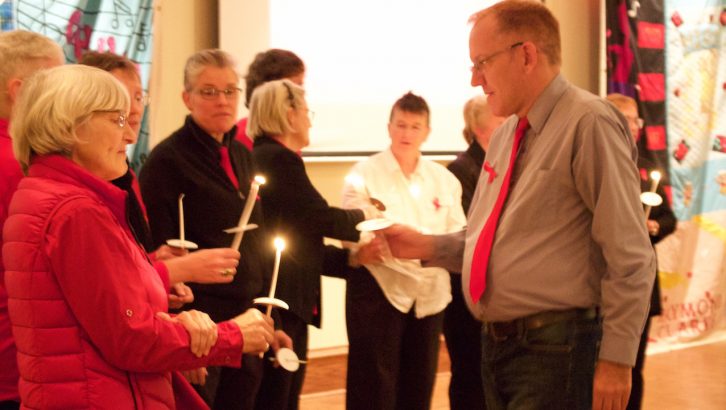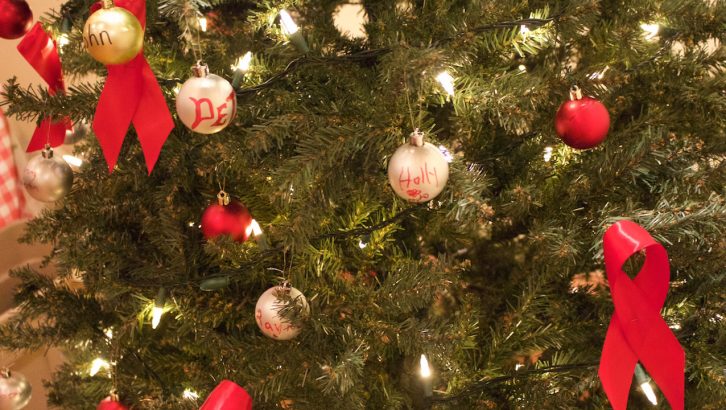HIV
World AIDS Day vigil: respecting the past, looking to the future
While honouring those who have died, AIDS Coalition focuses on new forms of prevention


caption
Chorus singers lead the candle lighting ceremony at the vigil.This AIDS awareness week, headway was made in AIDS prevention when the Canadian Medical Association Journal published guidelines for the distribution of a HIV prevention drug.
On a sombre Friday evening, the AIDS Coalition of Nova Scotia hosted its annual World AIDS Day vigil.
Dressed in red to commemorate those living with HIV or AIDS, and to honour those who have passed away, people shuffled in from the rain to the Italian Cultural Centre.
AIDS Awareness Week is held during the final week November and ends with World AIDS Day on Dec. 1.
“I’m gonna be 63 in March and I’m just believing (I can) … live a good, whole prosperous life as long as I continue to stay on the path that I’m on,” said Thomas Pottie during the ceremony. He’s had HIV for 10 years.
Pottie shared his story of contracting and living with HIV. There was also a candle lighting ceremony, poetry, singing, a reading of the names of people who have died from AIDS in Nova Scotia and a moment of silence.

caption
Quilts commemorating those who died from AIDS hung on the walls.According to the AIDS Coalition of Nova Scotia, 16 people were diagnosed with HIV in Nova Scotia in 2016. Since 1985, over 840 people have been diagnosed with HIV in the province. In Canada, the risk of HIV is 2.7 times higher in Indigenous communities than in other communities, according to a report published by the Canadian Medical Association Journal.
“Awareness is key because one new case of HIV is one case too many,” said Dena Simon, the coalition’s executive director, at the event.

caption
A Christmas tree at the vigil was decorated with the names of people who passed away.The CMAJ report, published Monday at the start of AIDS Awareness Week, is a guideline for health-care providers on how to distribute Pre-Exposure Prophylaxis, or PrEP, for HIV prevention.
PrEP is a pill taken daily that reduces the risk of transmitted HIV. The report recommends considering PrEP for people in high-risk communities, such as gay men, who make up over half of newly diagnosed HIV cases in Canada, and Indigenous people. PrEP is a form of prevention, much like the birth control pill, that people can choose to take if they are likely to have sex with someone with HIV.
Although Health Canada approved PrEP in February 2016, doctors have been hesitant to prescribe it because Canadian guidelines were not yet available, said Chris Aucoin, the gay men’s health co-ordinator for the coalition, in an interview before the vigil.
In urban centres in the United States and Europe, where PrEP is used as HIV prevention more commonly, HIV rates have dropped.
“That’s never been seen before, ever. That’s pretty significant,” said Aucoin.
Aucoin came out as gay the summer he turned 17, the same year AIDS was first reported as a media story by The New York Times in July 1981.
“So my entire adult life as a gay man has been framed by this epidemic,” said Aucoin. “I’ve heard many men of my generation talk about PrEP as the thing we’ve been waiting 30 years for is finally here.”
He urges people not to think of PrEP as the single answer to HIV prevention, but as a new, effective tool.
The patent on the branded PrEP, Truveda, expired this past summer, and generic versions have been approved. Aucoin expects the market competition, plus the new CMAJ guidelines to increase demand for PrEP in Nova Scotia.

caption
Candles honoured those who have died of AIDS.The coalition is holding a public information session on PrEP on Jan. 31 at 6:30 p.m. at the Halifax Central Library.

